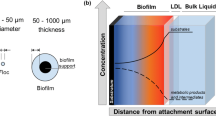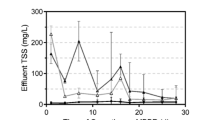Abstract
The objective of this study was to demonstrate the feasibility of novel, Horizontal Flow Biofilm Reactor (HFBR) technology for the treatment of ammonia (NH3)-contaminated airstreams. Three laboratory-scale HFBRs were used for remediation of an NH3-containing airstream at 10 °C during a 90-d trial to test the efficacy of low-temperature treatment. Average ammonia removal efficiencies of 99.7 % were achieved at maximum loading rates of 4.8 g NH3 m3 h−1. Biological nitrification of ammonia to nitrite (NO2 −) and nitrate (NO3 −) was mediated by nitrifying bacterial and archaeal biofilm populations. Ammonia-oxidising bacteria (AOB) were significantly more abundant than ammonia-oxidising archaea (AOA) vertically at each of seven sampling zones along the vertical HFBRs. Nitrosomonas and Nitrosospira, were the two most dominant bacterial genera detected in the HFBRs, while an uncultured archaeal clone dominated the AOA community. The bacterial community composition across the three HFBRs was highly conserved, although variations occurred between HFBR zones and were driven by physicochemical variables. The study demonstrates the feasibility of HFBRs for the treatment of ammonia-contaminated airstreams at low temperatures; identifies key nitrifying microorganisms driving the removal process; and provides insights for process optimisation and control. The findings are significant for industrial applications of gas oxidation technology in temperate climates.





Similar content being viewed by others
References
Aakra Å, Utåker JB, Nes IF (1999) RFLP of rRNA genes and sequencing of the 16S–23S rDNA intergenic spacer region of ammonia-oxidizing bacteria: a phylogenetic approach. Int J Syst Bacteriol 49:123–130. doi:10.1099/00207713-49-1-123
Alawi M, Lipski A, Sanders T, Eva Maria P, Spieck E (2007) Cultivation of a novel cold-adapted nitrite oxidizing betaproteobacterium from the Siberian Arctic. ISME J 1:256–264
Alawi M, Off S, Kaya M, Spieck E (2009) Temperature influences the population structure of nitrite-oxidizing bacteria in activated sludge. Environ Microbiol Rep 1:184–190. doi:10.1111/j.1758-2229.2009.00029.x
Avrahami S, Bohannan BJM (2007) Response of Nitrosospira sp. Strain AF-Like ammonia oxidizers to changes in temperature, soil moisture content, and fertilizer concentration. Appl Environ Microbiol 73:1166–1173. doi:10.1128/aem.01803-06
Awwa A (1998) Standard methods for the examination of water and wastewater. Standard Methods for the Examination of Water and Wastewater, Washington, DC 20
Bassam BJ, Caetano-Anollés G, Gresshoff PM (1991) Fast and sensitive silver staining of DNA in polyacrylamide gels. Anal Biochem 196:80–83
Chen S, Ling J, Blancheton JP (2006) Nitrification kinetics of biofilm as affected by water quality factors. Aquacult Eng 34:179–197. doi:10.1016/j.aquaeng.2005.09.004
Clarke KR (1993) Non-parametric multivariate analyses of changes in community structure. Aust J Ecol 18:117–143
Clarke KR, Clarke RK, Gorley RN (2006) Primer V6: user manual—tutorial. Plymouth Marine Laboratory, Plymouth
Clifford E, Kennelly C, Walsh R, Gerrity S, Reilly E, Collins G (2012) Optimization of a horizontal-flow biofilm reactor for the removal of methane at low temperatures. J Air Waste Manage Assoc 62:1166–1173
Clifford E, Rodgers M, de Paor D (2008) Dairy washwater treatment using a horizontal flow biofilm system. Water Sci Technol 58:1879–1888
Francis CA, Roberts KJ, Beman JM, Santoro AE, Oakley BB (2005) Ubiquity and diversity of ammonia-oxidizing archaea in water columns and sediments of the ocean. Proc Natl Acad Sci USA 102:14683–14688. doi:10.1073/pnas.0506625102
Geets J, de Cooman M, Wittebolle L, Heylen K, Vanparys B, De Vos P, Verstraete W, Boon N (2007) Real-time PCR assay for the simultaneous quantification of nitrifying and denitrifying bacteria in activated sludge. Appl Microbiol Biotechnol 75:211–221. doi:10.1007/s00253-006-0805-8
Hatzenpichler R (2012) Diversity, physiology, and niche differentiation of ammonia-oxidizing archaea. Appl Environ Microbiol 78:7501–7510. doi:10.1128/aem.01960-12
Jiang X, Yan R, Tay J (2009) Transient-state biodegradation behavior of a horizontal biotrickling filter in co-treating gaseous H2S and NH3. Appl Microbiol Biotechnol 81:969–975. doi:10.1007/s00253-008-1759-9
Jin T, Zhang T, Yan Q (2010) Characterization and quantification of ammonia-oxidizing archaea (AOA) and bacteria (AOB) in a nitrogen-removing reactor using T-RFLP and qPCR. Appl Microbiol Biotechnol 87:1167–1176. doi:10.1007/s00253-010-2595-2
Karkman A, Mattila K, Tamminen M, Virta M (2011) Cold temperature decreases bacterial species richness in nitrogen-removing bioreactors treating inorganic mine waters. Biotechnol Bioeng 108:2876–2883. doi:10.1002/bit.23267
Kembel SW, Wu M, Eisen JA, Green JL (2012) Incorporating 16S gene copy number information improves estimates of microbial diversity and abundance. PLoS Comput Biol 8:e1002743. doi:10.1371/journal.pcbi.1002743
Kennelly C, Gerrity S, Collins G, Clifford E (2014) Liquid phase optimisation in a horizontal flow biofilm reactor (HFBR) technology for the removal of methane at low temperatures. Chem Eng J 242:144–154. doi:10.1016/j.cej.2013.12.071
Larkin MA, Blackshields G, Brown N, Chenna R, McGettigan PA, McWilliam H, Valentin F, Wallace IM, Wilm A, Lopez R (2007) Clustal W and Clustal X version 2.0. Bioinformatics 23:2947–2948
Norton JM, Alzerreca JJ, Suwa Y, Klotz MG (2002) Diversity of ammonia monooxygenase operon in autotrophic ammonia-oxidizing bacteria. Arch Microbiol 177:139–149. doi:10.1007/s00203-001-0369-z
Norton JM, Stark JM (2011) Regulation and measurement of nitrification in terrestrial systems. Methods Enzymol 486:343–368
Phillips JP (2008) Development of innovative solutions for biological treatment of odour and voc emissions from municipal wastewater treatment applications. Proc Water Env Fed 2008:5317–5326. doi:10.2175/193864708788805215
Posmanik R, Gross A, Nejidat A (2014) Effect of high ammonia loads emitted from poultry-manure digestion on nitrification activity and nitrifier-community structure in a compost biofilter. Ecol Eng 62:140–147. doi:10.1016/j.ecoleng.2013.10.033
Prosser JI, Nicol GW (2012) Archaeal and bacterial ammonia-oxidisers in soil: the quest for niche specialisation and differentiation. Trends Microbiol 20:523–531. doi:10.1016/j.tim.2012.08.001
Qin W, Amin SA, Martens-Habbena W, Walker CB, Urakawa H, Devol AH, Ingalls AE, Moffett JW, Armbrust EV, Stahl DA (2014) Marine ammonia-oxidizing archaeal isolates display obligate mixotrophy and wide ecotypic variation. Proc Natl Acad Sci USA 111:12504–12509. doi:10.1073/pnas.1324115111
Robinson A, Di H, Cameron K, Podolyan A, He J (2014) The effect of soil pH and dicyandiamide (DCD) on N2O emissions and ammonia oxidiser abundance in a stimulated grazed pasture soil. J Soils Sed 14:1434–1444. doi:10.1007/s11368-014-0888-2
Rotthauwe JH, Witzel KP, Liesack W (1997) The ammonia monooxygenase structural gene amoA as a functional marker: molecular fine-scale analysis of natural ammonia-oxidizing populations. Appl Environ Microbiol 63:4704–4712
Ruiz G, Jeison D, Chamy R (2003) Nitrification with high nitrite accumulation for the treatment of wastewater with high ammonia concentration. Water Res 37:1371–1377. doi:10.1016/S0043-1354(02)00475-X
Sakuma T, Jinsiriwanit S, Hattori T, Deshusses MA (2008) Removal of ammonia from contaminated air in a biotrickling filter–denitrifying bioreactor combination system. Water Res 42:4507–4513
Schleper C, Nicol GW (2010) Ammonia-oxidising archaea—physiology, ecology and evolution. In: Robert KP (ed) Advances in microbial physiology, vol vol 57. Academic Press, Cambridge, pp 1–41. doi:10.1016/B978-0-12-381045-8.00001-1
Schloss PD, Westcott SL, Ryabin T, Hall JR, Hartmann M, Hollister EB, Lesniewski RA, Oakley BB, Parks DH, Robinson CJ (2009) Introducing mothur: open-source, platform-independent, community-supported software for describing and comparing microbial communities. Appl Environ Microbiol 75:7537–7541
Siripong S, Rittmann BE (2007) Diversity study of nitrifying bacteria in full-scale municipal wastewater treatment plants. Water Res 41:1110–1120. doi:10.1016/j.watres.2006.11.050
Taghipour H, Shahmansoury MR, Bina B, Movahdian H (2008) Operational parameters in biofiltration of ammonia-contaminated air streams using compost-pieces of hard plastics filter media. Chem Eng J 137:198–204. doi:10.1016/j.cej.2007.04.015
Tamura K, Peterson D, Peterson N, Stecher G, Nei M, Kumar S (2011) MEGA5: molecular evolutionary genetics analysis using maximum likelihood, evolutionary distance, and maximum parsimony methods. Mol Biol Evol 28:2731–2739
Taylor AE, Zeglin LH, Wanzek TA, Myrold DD, Bottomley PJ (2012) Dynamics of ammonia-oxidizing archaea and bacteria populations and contributions to soil nitrification potentials. ISME J 6:2024–2032. doi:10.1038/ismej.2012.51
Trias R, García-Lledó A, Sánchez N, López-Jurado JL, Hallin S, Bañeras L (2012) Abundance and composition of epiphytic bacterial and archaeal ammonia oxidizers of marine red and brown macroalgae. Appl Environ Microbiol 78:318–325
Wagner M, Loy A, Nogueira R, Purkhold U, Lee N, Daims H (2002) Microbial community composition and function in wastewater treatment plants. Antonie Van Leeuwenhoek 81:665–680. doi:10.1023/a:1020586312170
Wells GF, Park HD, Yeung CH, Eggleston B, Francis CA, Criddle CS (2009) Ammonia-oxidizing communities in a highly aerated full-scale activated sludge bioreactor: betaproteobacterial dynamics and low relative abundance of Crenarchaea. Environ Microbiol 11:2310–2328. doi:10.1111/j.1462-2920.2009.01958.x
Yasuda T, Waki M, Kuroda K, Hanajima D, Fukumoto Y, Yamagishi T, Suwa Y, Suzuki K (2013) Responses of community structure of amoA-encoding archaea and ammonia-oxidizing bacteria in ammonia biofilter with rockwool mixtures to the gradual increases in ammonium and nitrate. J Appl Microbiol 114:746–761. doi:10.1111/jam.12091
Yu Y, Lee C, Kim J, Hwang S (2005) Group-specific primer and probe sets to detect methanogenic communities using quantitative real-time polymerase chain reaction. Biotechnol Bioeng 89:670–679. doi:10.1002/bit.20347
Zápotocký L, Šváb M (2012) Removal of ammonia emissions from waste air in a biotrickling filter: pilot-scale demonstration in real conditions. Cent Eur J Chem 10:1049–1058. doi:10.2478/s11532-012-0010-9
Zhang T, Ye L, Tong A, Shao MF, Lok S (2011) Ammonia-oxidizing archaea and ammonia-oxidizing bacteria in six full-scale wastewater treatment bioreactors. Appl Microbiol Biotechnol 91:1215–1225. doi:10.1007/s00253-011-3408-y
Acknowledgements
This work was supported by Science Foundation Ireland under Grant 08/RFP/ENM1762; and a European Research Council Starting Grant (3C-BIOTECH; No. 261330) to GC.
Author information
Authors and Affiliations
Corresponding author
Rights and permissions
About this article
Cite this article
Gerrity, S., Clifford, E., Kennelly, C. et al. Ammonia oxidizing bacteria and archaea in horizontal flow biofilm reactors treating ammonia-contaminated air at 10 °C. J Ind Microbiol Biotechnol 43, 651–661 (2016). https://doi.org/10.1007/s10295-016-1740-z
Received:
Accepted:
Published:
Issue Date:
DOI: https://doi.org/10.1007/s10295-016-1740-z




